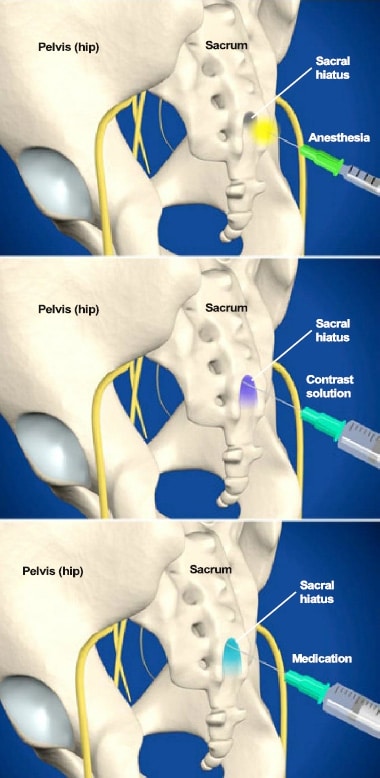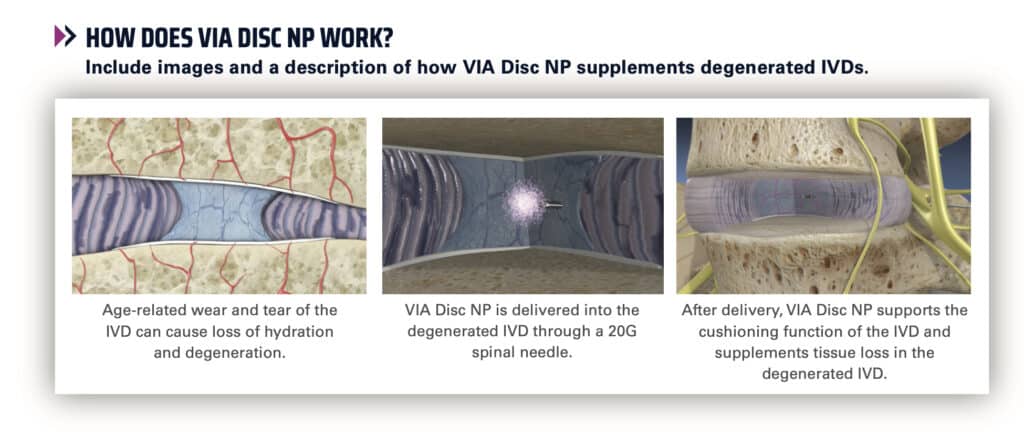Caudal Steroid Injection
If you suffer from chronic back and radiating leg pain, one solution may be caudal steroid injections. This pain management treatment delivers a combination of a steroid medication and a local anesthetic to your lower back.
The steroid medication can reduce the swelling, inflammation and irritation caused by spinal conditions, such as spinal stenosis, radiculopathy, sciatica and herniated discs.
OVERVIEW
Caudal steroid injections put medication right where it’s most needed: in the epidural space around irritated nerve roots. Your pain management physician uses a dye solution to better track his or her movements, as the sacral opening of your lower back is difficult to reach.
Once injected, the medicine moves to the most painful areas of your spine and reduces the inflammation that causes your pain. The procedure is detailed below. Talk to your surgeon about the risks and what to expect during your recovery.
 1. LOCATING THE SACRAL HIATUS
1. LOCATING THE SACRAL HIATUS
You must lie face down for this procedure with a cushion under your stomach for comfort and to arch your back. The back doctor uses a fluoroscope to find the small opening at the base of your sacrum called the sacral hiatus. Refer to the top illustration.
2. INJECTING THE ANESTHETIC
Once the doctor has located the sacral hiatus, he or she numbs the skin with a local anesthetic. Using the same thin needle, your doctor then applies the anesthetic to all the tissue down to the surface of the sacral hiatus. Again, see the top illustration.
3. INSERTING THE EPIDURAL NEEDLE
The physician then guides a second needle through the anesthetized track and into the epidural space of your lower spine. Your doctor carefully inserts the needle about one to two centimeters into the epidural space. The middle illustration shows this.
4. INJECTING THE CONTRAST DYE
Once inside the sacral hiatus space, a contrast or non-allergenic iodine-based solution is injected, as shown in the middle illustration. This solution helps the physician see the diseased or injured areas in the fluoroscope images. These are the places causing your pain.
5. INJECTING THE STEROID MEDICATION
Your physician injects the steroid/anesthetics mix into the epidural space, bathing the painful area in medication. This is shown in the bottom illustration.
6. RECOVERING FROM THE PROCEDURE
After removing the needle, the doctor covers the tiny surface wound with a small bandage. In some cases, it may be necessary to repeat the procedure as many as three times for you to feel the full benefit of the medication. Most patients, however, feel significant relief from only one or two injections.
You should feel pain relief quickly after this procedure. You can enjoy improved functionality and reduced pain for years with this treatment.
MORE INFORMATION
For more information about nerve blocks and epidurals, refer to the Southeastern Spine Institute (SSI) Block Suite.
Conservative care & rehabilitation (non-surgical procedures)

 1. LOCATING THE SACRAL HIATUS
1. LOCATING THE SACRAL HIATUS